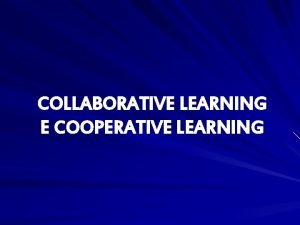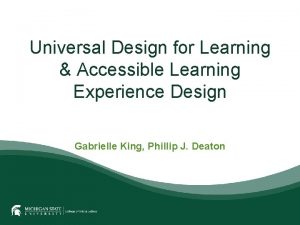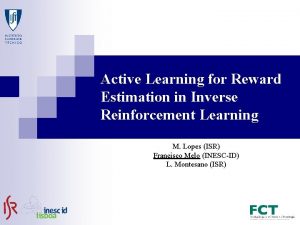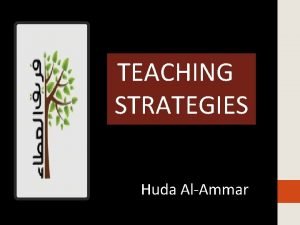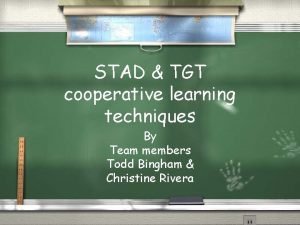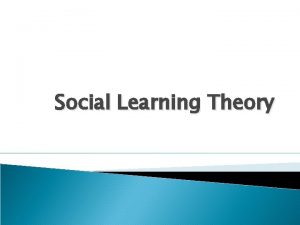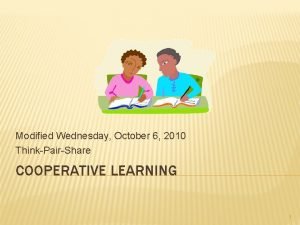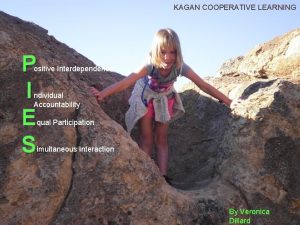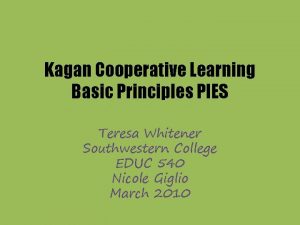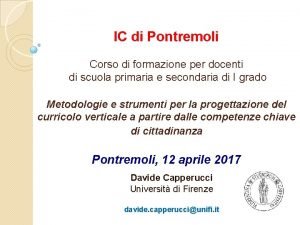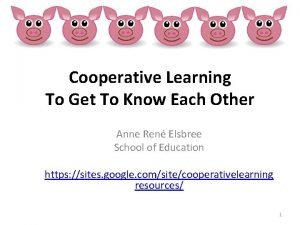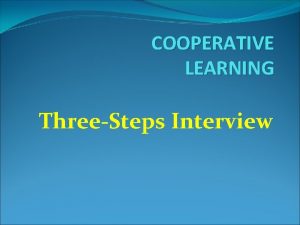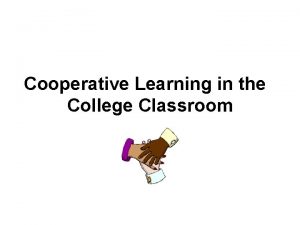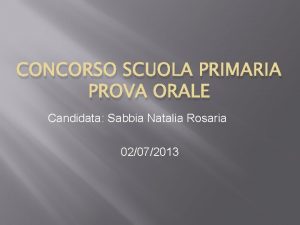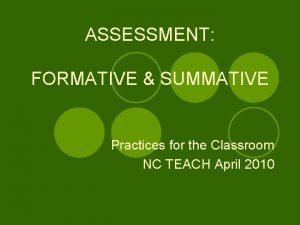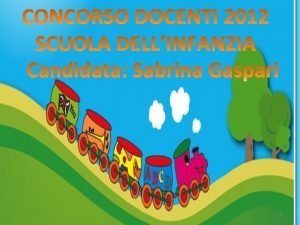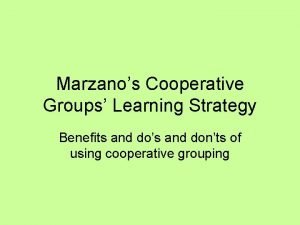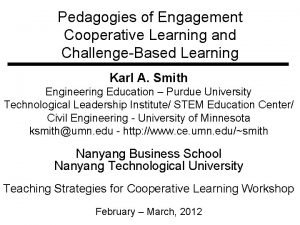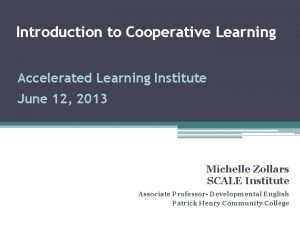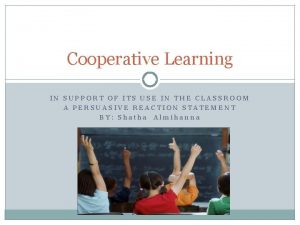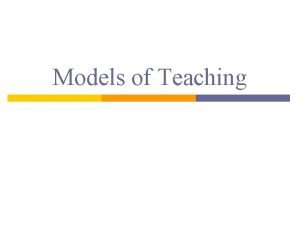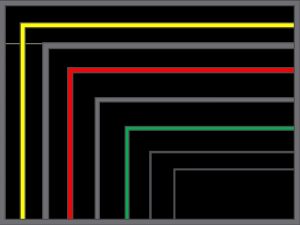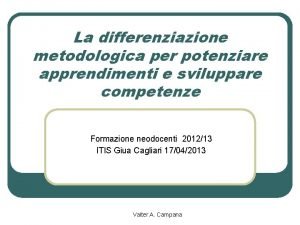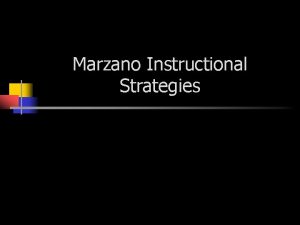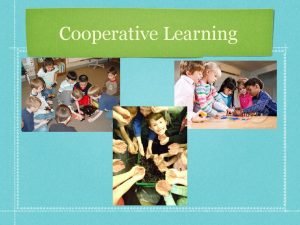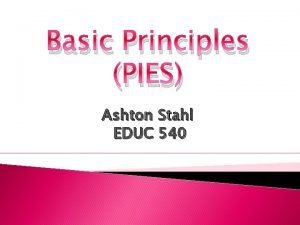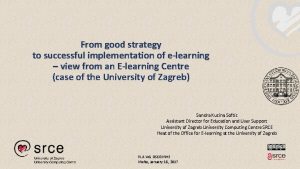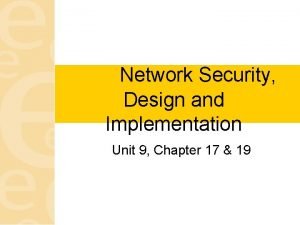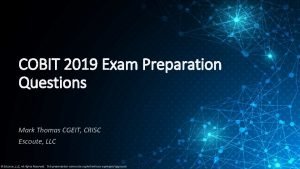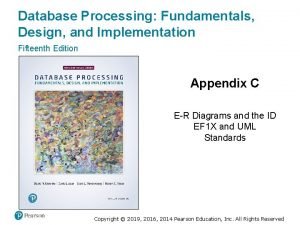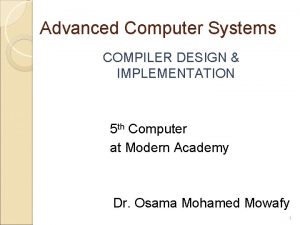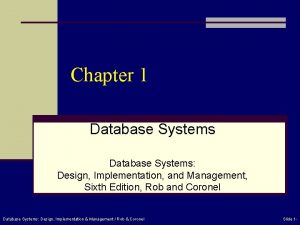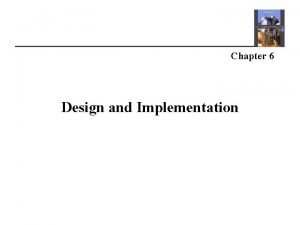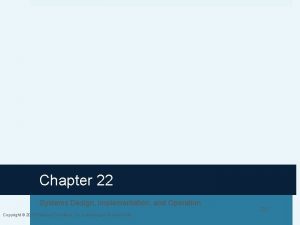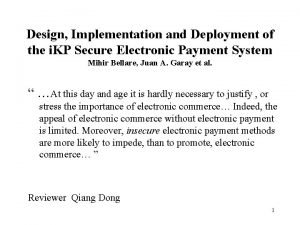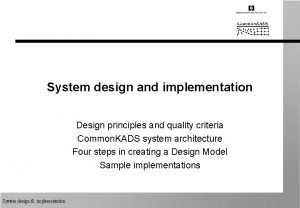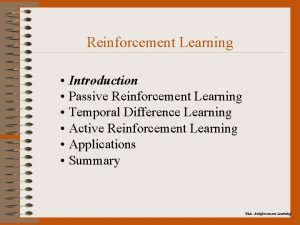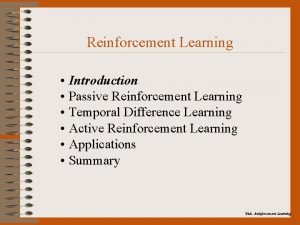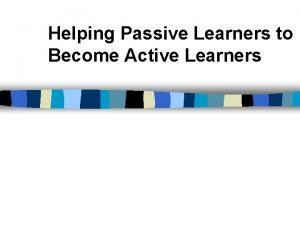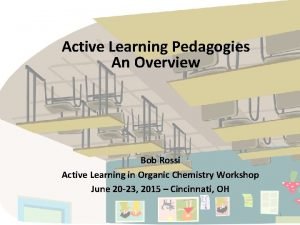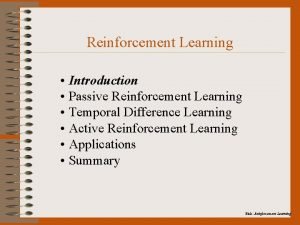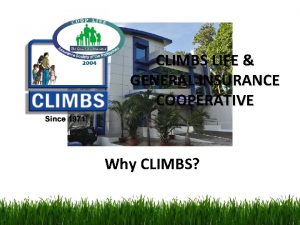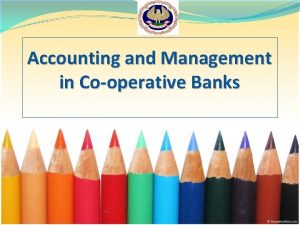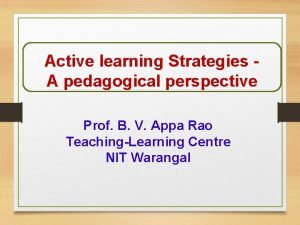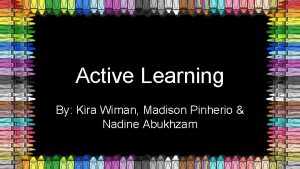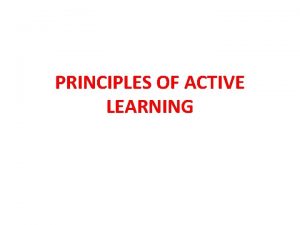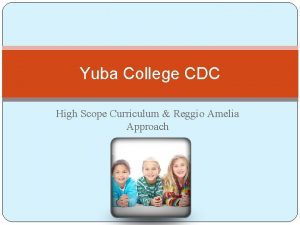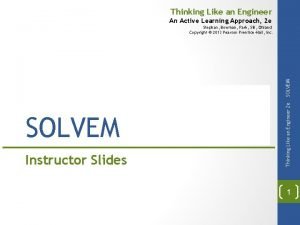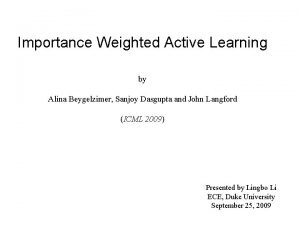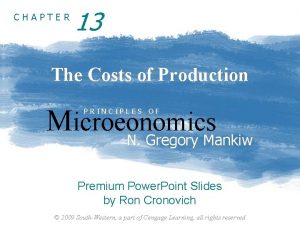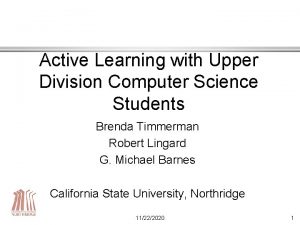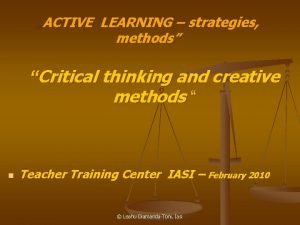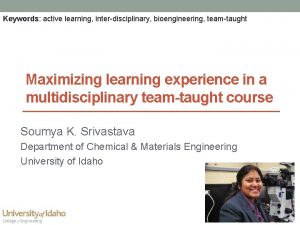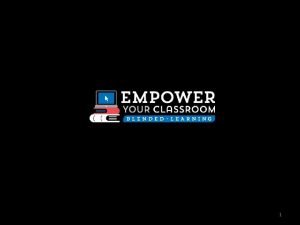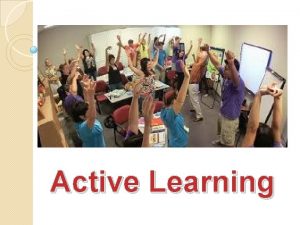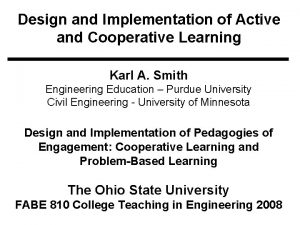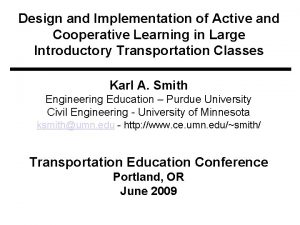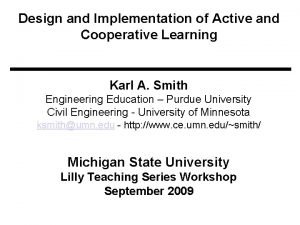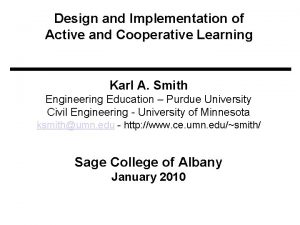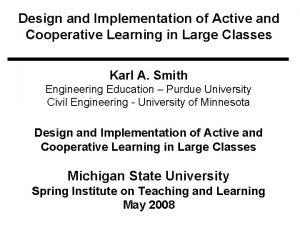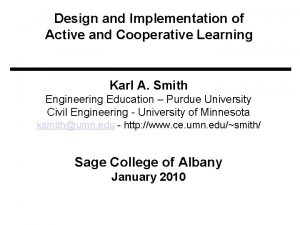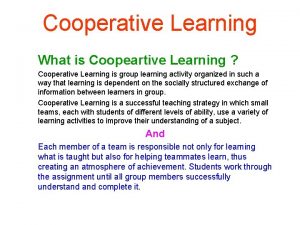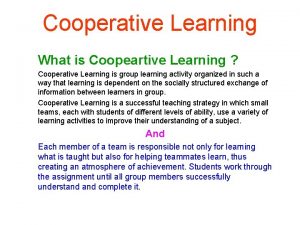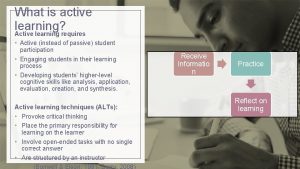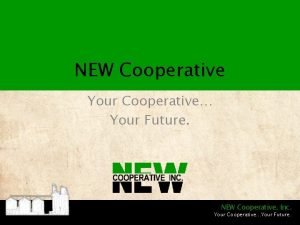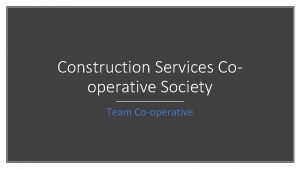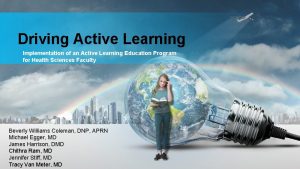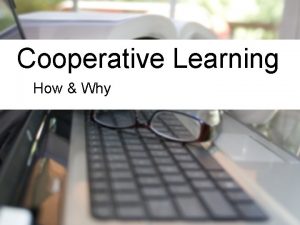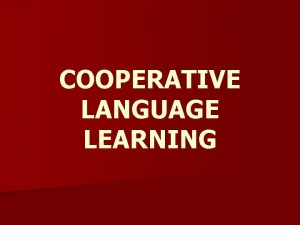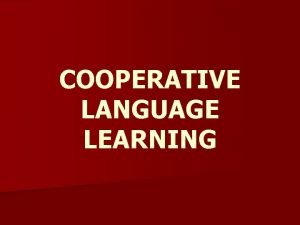Design and Implementation of Active and Cooperative Learning









































































- Slides: 73

Design and Implementation of Active and Cooperative Learning Karl A. Smith Engineering Education – Purdue University Civil Engineering - University of Minnesota ksmith@umn. edu http: //www. ce. umn. edu/~smith Workshop for the Carlson School of Management University of Minnesota October 15, 2010

Workshop Layout • Welcome & Overview • Integrated Course Design (CAP Model) – Content – Assessment – Pedagogy • Active and Cooperative Learning – Informal – Bookends on a Class Session – Formal Cooperative Learning • Problem-Based Learning • Develop an Application • Wrap-up and Next Steps 2

Workshop Objectives • Participants will be able to – Describe how active and cooperative learning supports deep learning – Describe design and facilitation decisions and options associated with implementing active and cooperative learning – Develop an application of active and cooperative learning to a deep learning task in course – Identify additional active and cooperative learning techniques and associated applications in course 3

It could well be that faculty members of the twenty-first century college or university will find it necessary to set aside their roles as teachers and instead become designers of learning experiences, processes, and environments. James Duderstadt, 1999 [Nuclear Engineering Professor; Dean, Provost and President of the University of Michigan] 4

Integrated Course Design Models • Understanding By Design - Backward Design Approach – Course, Class Session, and Learning Module Design: From Objectives and Evidence to Instruction (Wiggins & Mc. Tighe, 1998 and Bransford, Vye & Bateman, 2002) • Curriculum-Instruction-Assessment Triad (Pellegrino, 2006) • Fink, L. D. 2003. Creating significant learning experiences: An integrated approach to designing. Jossey-Bass 5

Some Important Principles About Learning and Understanding The first important principle about how people learn is that students come to the classroom with preconceptions about how the world works which include beliefs and prior knowledge acquired through various experiences. The second important principle about how people learn is that to develop competence in an area of inquiry, students must: (a) have a deep foundation of factual knowledge, (b) understand facts and ideas in the context of a conceptual framework, and (c) organize knowledge in ways that facilitate retrieval and application. A third critical idea about how people learn is that a “metacognitive” approach to instruction can help students learn to take control of their own learning by defining learning goals and monitoring their progress in achieving them. Jim Pellegrino (2006) – Rethinking and redesigning curriculum, instruction and assessment: What contemporary research and theory suggests. http: //www. skillscommission. org/commissioned. htm 6

Dee Fink A Self-Directed Guide to Designing Courses for Significant Learning http: //www. deefinkandassociates. com/Guideto. Course. Design. Aug 05. pdf 7

Cooperative Learning • Theory – Social Interdependence – Lewin – Deutsch – Johnson & Johnson • Research – Randomized Design Field Experiments • Practice – Formal Teams/Professor’s Role Theory Research Practice

Cooperative Learning • Positive Interdependence • Individual and Group Accountability • Face-to-Face Promotive Interaction • Teamwork Skills • Group Processing

Cooperative Learning is instruction that involves people working in teams to accomplish a common goal, under conditions that involve both positive interdependence (all members must cooperate to complete the task) and individual and group accountability (each member is accountable for the complete final outcome). Key Concepts • Positive Interdependence • Individual and Group Accountability • Face-to-Face Promotive Interaction • Teamwork Skills • Group Processing

Cooperative Learning Research Support Johnson, D. W. , Johnson, R. T. , & Smith, K. A. 1998. Cooperative learning returns to college: What evidence is there that it works? Change, 30 (4), 26 -35. • Over 300 Experimental Studies • First study conducted in 1924 • High Generalizability • Multiple Outcomes 1. Achievement and retention 2. Critical thinking and higher-level reasoning 3. Differentiated views of others 4. Accurate understanding of others' perspectives 5. Liking for classmates and teacher 6. Liking for subject areas 7. Teamwork skills January 2005 March 2007

Student Engagement Research Evidence • Perhaps the strongest conclusion that can be made is the least surprising. Simply put, the greater the student’s involvement or engagement in academic work or in the academic experience of college, the greater his or her level of knowledge acquisition and general cognitive development …(Pascarella and Terenzini, 2005). • Active and collaborative instruction coupled with various means to encourage student engagement invariably lead to better student learning outcomes irrespective of academic discipline (Kuh et al. , 2005, 2007). See Smith, et. al, 2005 and Fairweather, 2008, Linking Evidence and Promising Practices in Science, Technology, Engineering, and Mathematics (STEM) 12 Undergraduate Education - http: //www 7. nationalacademies. org/bose/Fairweather_Commissioned. Paper. pdf

Reflection and Dialogue • Individually reflect on your familiarity with (1) Integrated Course Design and (2) Active and Cooperative Learning. Write for about 1 minute – Key ideas, insights, applications – Success Stories – Questions, concerns, challenges • Discuss with your neighbor for about 3 minutes – Select one Insight, Success Story, Comment, Question, etc. that you would like to present to the whole group if you are randomly selected • Whole group discussion

Key Resources http: //books. google. com/books? id=N 2 Ef. Kly. UN 4 QC&printsec=frontcover&sour ce=gbs_v 2_summary_r&cad=0#v=onepage&q=&f=false • Wiggins & Mc. Tighe – Understanding by Design • Pellegrino – Rethinking and Redesigning Curriculum, Instruction and Assessment 14 http: //www. skillscommission. org/commissioned. htm

Understanding By Design Backward Design Approach Wiggins & Mc. Tighe Stage 1. Identify Desired Results Stage 2. Determine Acceptable Evidence Stage 3. Plan Learning Experiences and Instruction Wiggins, Grant and Mc. Tighe, Jay. 1998. Understanding by Design. Alexandria, VA: ASCD 15

Backward Design Approach Wiggins & Mc. Tighe Stage 1. Identify Desired Results • Enduring understanding • Important to know and do • Worth being familiar with Stage 2. Determine Acceptable Evidence Stage 3. Plan Learning Experiences and Instruction From: Wiggins, Grant and Mc. Tighe, Jay. 1998. Understanding by Design. Alexandria, VA: ASCD 16

Establishing Curricular Priorities 17

Backward Design Stage 1. Identify Desired Results Filter 1. To what extent does the idea, topic, or process represent a big idea or having enduring value beyond the classroom? Filter 2. To what extent does the idea, topic, or process reside at the heart of the discipline? Filter 3. To what extent does the idea, topic, or process require uncoverage? Filter 4. To what extent does the idea, topic, or process offer potential for engaging students? 18

Worksheet 1 Worksheet for Designing a Course/Class Session/Learning Module Learning Goals for Course/Session/Learning Module: Ways of Assessing Actual Teaching-Learning Helpful Resources: This Kind of Learning: Activities: (e. g. , people, things) 1. 2. 3. 4. 5. 6. 19

Backward Design Stage 2. Determine Acceptable Evidence Types of Assessment Quiz and Test Items: Simple, content-focused test items Academic Prompts: Open-ended questions or problems that require the student to think critically Performance Tasks or Projects: Complex challenges that mirror the issues or problems faced by graduates, they are authentic 20

Taxonomies of Types of Learning Bloom’s taxonomy of educational objectives: Cognitive Domain (Bloom & Krathwohl, 1956) A taxonomy for learning, teaching, and assessing: A revision of Bloom’s taxonomy of educational objectives (Anderson & Krathwohl, 2001). Facets of understanding (Wiggins & Mc. Tighe, 1998) Taxonomy of significant learning (Fink, 2003) Evaluating the quality of learning: The SOLO taxonomy (Biggs & Collis, 1982) 21

The Six Major Levels of Bloom's Taxonomy of the Cognitive Domain (with representative behaviors and sample objectives) Knowledge. Remembering information Define, identify, label, state, list, match Identify the standard peripheral components of a computer Write the equation for the Ideal Gas Law Comprehension. Explaining the meaning of information Describe, generalize, paraphrase, summarize, estimate In one sentence explain the main idea of a written passage Describe in prose what is shown in graph form Application. Using abstractions in concrete situations Determine, chart, implement, prepare, solve, use, develop Using principles of operant conditioning, train a rate to press a bar Derive a kinetic model from experimental data Analysis. Breaking down a whole into component parts Points out, differentiate, distinguish, discriminate, compare Identify supporting evidence to support the interpretation of a literary passage Analyze an oscillator circuit and determine the frequency of oscillation Synthesis. Putting parts together to form a new and integrated whole Create, design, plan, organize, generate, write Write a logically organized essay in favor of euthanasia Develop an individualized nutrition program for a diabetic patient Evaluation. Making judgments about the merits of ideas, materials, or phenomena Appraise, critique, judge, weigh, evaluate, select Assess the appropriateness of an author's conclusions based on the evidence given Select the best proposal for a proposed water treatment plant 22

The Cognitive Process Dimension Remember Understand Apply Analyze Evaluate Create Factual Knowledge – The basic The Knowledge Dimension elements that students must know to be acquainted with a discipline or solve problems in it. a. Knowledge of terminology b. Knowledge of specific details and elements Conceptual Knowledge – The interrelationships among the basic elements within a larger structure that enable them to function together. a. Knowledge of classifications and categories b. Knowledge of principles and generalizations c. Knowledge of theories, models, and structures Procedural Knowledge – How to do something; methods of inquiry, and criteria for using skills, algorithms, techniques, and methods. a. Knowledge of subject-specific skills and algorithms b. Knowledge of subject-specific techniques and methods c. Knowledge of criteria for determining when to use appropriate procedures Metacognitive Knowledge – Knowledge of cognition in general as well as awareness and knowledge of one’s own cognition. a. Strategic knowledge b. Knowledge about cognitive tasks, including appropriate contextual and conditional knowledge c. Self-knowledge 23 (Anderson & Krathwohl, 2001).

24

25

Facets of Understanding Wiggins & Mc. Tighe, 1998, page 44 When we truly understand, we Can explain - cognitive Can interpret - cognitive Can apply - cognitive Have perspective - affective Can empathize - affective Have self-knowledge metacognitive 26

C o g n i t i v e A f f e c t i v e M e t a

SOLO Taxonomy Deep Learning Surface Learning • The Structure of Observed Learning Outcome (SOLO) model consists of 5 levels of understanding – Pre-structural - The task is not attacked appropriately; the student hasn’t really understood the point and uses too simple a way of going about it. – Uni-structural - The student's response only focuses on one relevant aspect. – Multi-structural - The student's response focuses on several relevant aspects but they are treated independently and additively. Assessment of this level is primarily quantitative. – Relational - The different aspects have become integrated into a coherent whole. This level is what is normally meant by an adequate understanding of some topic. – Extended abstract - The previous integrated whole may be conceptualised at a higher level of abstraction and generalised to a new topic or area. http: //en. wikipedia. org/wiki/Structure_of_Observed_Learning_Outcome

Backward Design Stage 3. Plan Learning Experiences & Instruction • What enabling knowledge (facts, concepts, and principles) and skills (procedures) will students need to perform effectively and achieve desired results? • What activities will equip students with the needed knowledge and skills? • What will need to be taught and coached, and how should it be taught, in light of performance goals? • What materials and resources are best suited to accomplish these goals? • Is the overall design coherent and effective? 29

Active and Cooperative Learning January 13, 2009—New York Times http: //www. nytimes. com/2009/01/13/us/13 physics. html? em January 2, 2009—Science, Vol. 323 www. sciencemag. org Calls for evidence-based promising practices

http: //web. mit. edu/edtech/casestudies/teal. html#video

http: //www. ncsu. edu/PER/scaleup. html

Lila M. Smith

Pedago-pathologies Amnesia Fantasia Inertia Lee Shulman – MSU Med School – PBL Approach (late 60 s – early 70 s), President Emeritus of the Carnegie Foundation for the Advancement of College Teaching Shulman, Lee S. 1999. Taking learning seriously. Change, 31 (4), 11 -17.

What do we do about these pathologies? • Activity – Engage learners in meaningful and purposeful activities • Reflection – Provide opportunities • Collaboration – Design interaction • Passion – Connect with things learners care about Shulman, Lee S. 1999. Taking learning seriously. Change, 31 (4), 11 -17. 35

Lila M. Smith

Pedagogies of Engagement 37

The American College Teacher: National Norms for 2007 -2008 Methods Used in “All” or “Most” Cooperative Learning Group Projects All – 2005 48 All – 2008 59 Assistant 2008 66 33 36 61 Grading on a curve Term/research papers 19 17 14 35 44 47 38 http: //www. heri. ucla. edu/index. php

Active Learning: Cooperation in the College Classroom • Informal Cooperative Learning Groups • Formal Cooperative Learning Groups • Cooperative Base Groups See Cooperative Learning Handout (CL College-804. doc) 39

Cooperative Learning is instruction that involves people working in teams to accomplish a common goal, under conditions that involve both positive interdependence (all members must cooperate to complete the task) and individual and group accountability (each member is accountable for the complete final outcome). Key Concepts • Positive Interdependence • Individual and Group Accountability • Face-to-Face Promotive Interaction • Teamwork Skills • Group Processing

41 http: //www. ce. umn. edu/~smith/docs/Smith-CL%20 Handout%2008. pdf

Book Ends on a Class Session 42

Book Ends on a Class Session 1. Advance Organizer 2. Formulate-Share-Listen-Create (Turn-to -your-neighbor) -- repeated every 10 -12 minutes 3. Session Summary (Minute Paper) 1. What was the most useful or meaningful thing you learned during this session? 2. What question(s) remain uppermost in your mind as we end this session? 3. What was the “muddiest” point in this session?

Advance Organizer “The most important single factor influencing learning is what the learner already knows. Ascertain this and teach him accordingly. ” David Ausubel - Educational psychology: A cognitive approach, 1968. 44

Quick Thinks • Reorder the steps • Paraphrase the idea • Correct the error • Support a statement • Select the response Johnston, S. & Cooper, J. 1997. Quick thinks: Activethinking in lecture classes and televised instruction. Cooperative learning and college teaching, 8(1), 2 -7. 45

Formulate-Share-Listen-Create Informal Cooperative Learning Group Introductory Pair Discussion of a FOCUS QUESTION 1. Formulate your response to the question individually 2. Share your answer with a partner 3. Listen carefully to your partner's answer 4. Work together to Create a new answer through discussion 46

Minute Paper • What was the most useful or meaningful thing you learned during this session? • What question(s) remain uppermost in your mind as we end this session? • What was the “muddiest” point in this session? • Give an example or application • Explain in your own words. . . Angelo, T. A. & Cross, K. P. 1993. Classroom assessment techniques: A handbook for college teachers. San Francisco: Jossey Bass. 47

Session Summary (Minute Paper) Reflect on the session: 1. Most interesting, valuable, useful thing you learned. 2. Things that helped you learn. 3. Question, comments, suggestions. 4. Pace: Too slow 1. . 5 Too fast 5. Relevance: Little 1. . . 5 Lots 6. Instructional Format: Ugh 1. . . 5 Ah 48

MOT 8221 – Spring 2010 – Session 1 (1/29/10) Q 4 – Pace: Too slow 1. . 5 Too fast (3. 0) Q 5 – Relevance: Little 1. . . 5 Lots (3. 9) Q 6 – Format: Ugh 1. . . 5 Ah (4. 1)

UMN CSOM Workshop – October 15, 2010 – Session 1 Q 4 – Pace: Too slow 1. . 5 Too fast (3. 3) Q 5 – Relevance: Little 1. . . 5 Lots (4. 2) Q 6 – Format: Ugh 1. . . 5 Ah (4. 4) 50

Informal CL (Book Ends on a Class Session) with Concept Tests Physics Peer Instruction Eric Mazur - Harvard – http: //galileo. harvard. edu Peer Instruction – www. prenhall. com Richard Hake – http: //www. physics. indiana. edu/~hake/ Chemistry Concep. Tests - UW Madison www. chem. wisc. edu/~concept Video: Making Lectures Interactive with Concep. Tests Modular. Chem Consortium – http: //mc 2. cchem. berkeley. edu/ STEMTEC Video: How Change Happens: Breaking the “Teach as You Were Taught” Cycle – Films for the Humanities & Sciences – www. films. com Harvard Thinking Together & From Questions to Concepts Interactive Teaching in Physics: Derek Bok Center – www. fas. harvard. edu/~bok_cen/ 51

The “Hake” Plot of FCI 35. 00 SDI 30. 00 X ALS UMn-CL+PS WP 25. 00 20. 00 UMn Cooperative Groups 15. 00 X PI(HU) UMn Traditional ASU(nc) 10. 00 WP* ASU(c) HU 5. 00 0. 00 20. 00 30. 00 40. 00 52 (Percent) Pretest 60. 00 70. 00 80. 00

Richard Hake (Interactive engagement vs traditional methods) http: //www. physics. indiana. edu/~hake/ Traditional (lecture) Interactive (active/cooperative) <g> = Concept Inventory Gain/Total

54

Physics (Mechanics) Concepts: The Force Concept Inventory (FCI) • A 30 item multiple choice test to probe student's understanding of basic concepts in mechanics. • The choice of topics is based on careful thought about what the fundamental issues and concepts are in Newtonian dynamics. • Uses common speech rather than cueing specific physics principles. • The distractors (wrong answers) are based on students' common inferences. 55

Informal Cooperative Learning Groups Can be used at any time Can be short term and ad hoc May be used to break up a long lecture Provides an opportunity for students to process material they have been listening to (Cognitive Rehearsal) Are especially effective in large lectures Include "book ends" procedure Are not as effective as Formal Cooperative Learning or Cooperative Base Groups

Strategies for Energizing Large Classes: From Small Groups to Learning Communities: Jean Mac. Gregor, James Cooper, Karl Smith, Pamela Robinson New Directions for Teaching and Learning, No. 81, 2000. Jossey- Bass

Active Learning: Cooperation in the College Classroom • Informal Cooperative Learning Groups • Formal Cooperative Learning Groups • Cooperative Base Groups See Cooperative Learning Handout (CL College-804. doc) 58

Formal Cooperative Learning Task Groups

http: //www. aacu. org/advocacy/leap/documents/Re 8097 abcombined. pdf 60

Top Three Main Engineering Work Activities Civil/Architectural • Management – 45% • Design – 39% • Computer applications – 20% Engineering Total • Design – 36% • Computer applications – 31% • Management – 29% Burton, L. , Parker, L, & Le. Bold, W. 1998. U. S. engineering career trends. ASEE Prism, 7(9), 18 -21. 61

Teamwork Skills • Communication • Listening and Persuading • Decision Making • Conflict Management • Leadership • Trust and Loyalty 62

Design Thinking Discipline Thinking Ideo's five-point model for strategizing by design: Hit the Streets Recruit T-Shaped People Build to Think The Prototype Tells a Story Design Is Never Done Tom Friedman Horizontalize Ourselves CQ+PQ>IQ 63 AAC&U College Learning For the New Global Century

Professor's Role in Formal Cooperative Learning 1. Specifying Objectives 2. Making Decisions 3. Explaining Task, Positive Interdependence, and Individual Accountability 4. Monitoring and Intervening to Teach Skills 5. Evaluating Students' Achievement and Group Effectiveness 64

Formal Cooperative Learning – Types of Tasks 1. Jigsaw – Learning new conceptual/procedural material 2. Peer Composition or Editing 3. Reading Comprehension/Interpretation 4. Problem Solving, Project, or Presentation 5. Review/Correct Homework 6. Constructive Academic Controversy 7. Group Tests

Challenge-Based Learning • • • Problem-based learning Case-based learning Project-based learning Learning by design Inquiry learning Anchored instruction John Bransford, Nancy Vye and Helen Bateman. Creating High-Quality Learning Environments: Guidelines from Research on How People Learn 66

Challenge-Based Instruction with the Legacy Cycle The Challenges Generate Ideas Go Public Legacy Cycle Test Your Mettle Multiple Perspectives Research & Revise https: //repo. vanth. org/portal/public-content/star-legacy-cycle 67

Problem-Based Learning START Apply it Problem posed Learn it Identify what we need to know 68

Problem-Based Cooperative Learning Karl A. Smith Engineering Education – Purdue University Civil Engineering - University of Minnesota ksmith@umn. edu http: //www. ce. umn. edu/~smith Estimation Exercise 69

Problem Based Cooperative Learning Format TASK: Solve the problem(s) or Complete the project. INDIVIDUAL: Estimate answer. Note strategy. COOPERATIVE: One set of answers from the group, strive for agreement, make sure everyone is able to explain the strategies used to solve each problem. EXPECTED CRITERIA FOR SUCCESS: Everyone must be able to explain the strategies used to solve each problem. EVALUATION: Best answer within available resources or constraints. INDIVIDUAL ACCOUNTABILITY: One member from your group may be randomly chosen to explain (a) the answer and (b) how to solve each problem. EXPECTED BEHAVIORS: Active participating, checking, encouraging, and elaborating by all members. INTERGROUP COOPERATION: Whenever it is helpful, check procedures, 70 answers, and strategies with another group.

71 http: //www. udel. edu/pbl/

Cooperative Base Groups • Are Heterogeneous • Are Long Term (at least one quarter or semester) • Are Small (3 -5 members) • Are for support • May meet at the beginning of each session or may meet between sessions • Review for quizzes, tests, etc. together • Share resources, references, etc. for individual projects • Provide a means for covering for absentees 72

Design and Implementation of Cooperative Learning – Resources • Design Framework – How People Learn (HPL) – Creating High Quality Learning Environments (Bransford, Vye & Bateman) -http: //www. nap. edu/openbook/0309082927/html/ • Design & Backward Design Process (Felder & Brent, Fink and Wiggins & Mc. Tighe) – Pellegrino – Rethinking and redesigning curriculum, instruction and assessment: What contemporary research and theory suggests. http: //www. skillscommission. org/commissioned. htm – Smith, K. A. , Douglas, T. C. , & Cox, M. 2009. Supportive teaching and learning strategies in STEM education. In R. Baldwin, (Ed. ). Improving the climate for undergraduate teaching in STEM fields. New Directions for Teaching and Learning, 117, 19 -32. San Francisco: Jossey. Bass. • Content Resources – Donald, Janet. 2002. Learning to think: Disciplinary perspectives. San Francisco: Jossey-Bass. – Middendorf, Joan and Pace, David. 2004. Decoding the Disciplines: A Model for Helping Students Learn Disciplinary Ways of Thinking. New Directions for Teaching and Learning, 98. • Active and Cooperative Learning - Instructional Format explanation and exercise to model format and to engage workshop participants – Cooperative Learning (Johnson, Johnson & Smith) • Smith web site – www. ce. umn. edu/~smith – University of Delaware PBL web site – www. udel. edu/pbl – PKAL – Pedagogies of Engagement – http: //www. pkal. org/activities/Pedagogies. Of. Engagement. Summit. cfm – Fairweather (2008) Linking Evidence and Promising Practices in Science, Technology, Engineering, and Mathematics (STEM) Undergraduate Education http: //www 7. nationalacademies. org/bose/Fairweather_Commissioned. Paper. pdf 73
 Collaborative learning vs cooperative learning
Collaborative learning vs cooperative learning Accessible learning experience design and implementation
Accessible learning experience design and implementation Active and passive learners
Active and passive learners Inverse reinforcement learning
Inverse reinforcement learning Cooperative vs collaborative learning
Cooperative vs collaborative learning Tgt cooperative learning
Tgt cooperative learning Social learning theory def
Social learning theory def Pedagogia non direttiva rogers
Pedagogia non direttiva rogers Think pair share cooperative learning
Think pair share cooperative learning Pies kagan cooperative learning
Pies kagan cooperative learning Kagan principles
Kagan principles Griglia di osservazione cooperative learning
Griglia di osservazione cooperative learning Pigs face cooperative learning
Pigs face cooperative learning Three step interview cooperative learning
Three step interview cooperative learning Example of cooperative learning
Example of cooperative learning Griglia di osservazione cooperative learning
Griglia di osservazione cooperative learning Evaluation continuum
Evaluation continuum Griglia di osservazione cooperative learning
Griglia di osservazione cooperative learning Marzano cooperative learning
Marzano cooperative learning Formal cooperative learning
Formal cooperative learning Cooperative learning institute
Cooperative learning institute Types of cooperative learning
Types of cooperative learning Approach of cooperative learning
Approach of cooperative learning Selection of teaching methods
Selection of teaching methods Classificazione delle metodologie didattiche
Classificazione delle metodologie didattiche Marzano strategies
Marzano strategies Formal cooperative learning
Formal cooperative learning Cooperative learning round robin
Cooperative learning round robin Cooperative learning pies
Cooperative learning pies Cuadro comparativo e-learning y b-learning
Cuadro comparativo e-learning y b-learning Active high and active low
Active high and active low Primary active transport and secondary active transport
Primary active transport and secondary active transport Primary active transport vs secondary active transport
Primary active transport vs secondary active transport Elearning project implementation
Elearning project implementation Network security design and implementation
Network security design and implementation Uiecu
Uiecu Cobit 2019 foundation exam questions
Cobit 2019 foundation exam questions Azure deployment planning services
Azure deployment planning services Pearson physics
Pearson physics Channel design and implementation
Channel design and implementation Advanced compiler design and implementation
Advanced compiler design and implementation Database system design implementation and management
Database system design implementation and management Design and implementation issues of dsm
Design and implementation issues of dsm Design and implementation of data plane
Design and implementation of data plane In design and implementation, reuse levels are:
In design and implementation, reuse levels are: System design implementation and operation
System design implementation and operation I kp
I kp Database system design implementation and management
Database system design implementation and management Implementation design principles
Implementation design principles Active and passive reinforcement learning
Active and passive reinforcement learning What is passive reinforcement learning
What is passive reinforcement learning What is the difference between passive and active learning
What is the difference between passive and active learning What is the difference between passive and active learning
What is the difference between passive and active learning Passive learning
Passive learning Passive reinforcement
Passive reinforcement Climbs insurance logo
Climbs insurance logo This type of work
This type of work Iphil savings and credit cooperative
Iphil savings and credit cooperative Crr for cooperative banks
Crr for cooperative banks Active learning strategies to promote critical thinking
Active learning strategies to promote critical thinking Conclusion of active learning
Conclusion of active learning Kira & nadine
Kira & nadine Active learning principles
Active learning principles Principles of active learning
Principles of active learning Montessori active learning
Montessori active learning Cognitive theory child development
Cognitive theory child development Yuba college child development center
Yuba college child development center Thinking like an engineer an active learning approach
Thinking like an engineer an active learning approach Importance weighted active learning
Importance weighted active learning Chapter 13 the cost of production
Chapter 13 the cost of production Computer science active learning
Computer science active learning Active learning strategies to promote critical thinking
Active learning strategies to promote critical thinking Quescussion activity
Quescussion activity Bioengineering flipped classroom
Bioengineering flipped classroom
